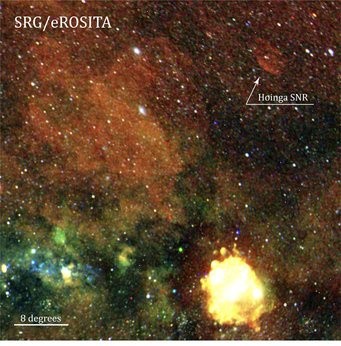Astronomers found Hoinga, the largest supernova remnant (SNR), using the eROSITA X-ray telescope onboard the Spektrum-Roentgen-Gamma (SRG) observatory.

The supernova remnant of Hoinga is massive and far from the galactic plane. It occupies an area approximately 90 times larger than the full Moon, with a diameter of about 4.4 degrees. Furthermore, it is located very far from the galactic plane, which is rare.
SNRs are diffuse, spreading systems that arise from a supernova explosion, according to Phys.org. They include ejected debris from the blast and other interstellar material sucked up by the shockwave from the exploding star.
Astronomers are interested in supernova remnants because they play an important role in the evolution of galaxies, dispersing the heavy elements produced by supernova explosions and supplying the energy required to warm up the interstellar medium (ISM). Experts also believed that SNRs caused the acceleration of interstellar cosmic rays.
New SNRs in X-rays can be detected using certain projects, such as the eROSITA All-Sky Survey (eRASS). With the telescope's assistance, a team of astronomers headed by Dr. Natasha Hurley-Walker of the Max Planck Institute for Extraterrestrial Physics in Garching, Germany, announced such a discovery.
They detailed their discovery in a paper released on the arXiv pre-print server on February 26. Their study's title is "Hoinga: A Supernova Remnant Discovered in the Srg/Erosita All-Sky Survey eRASS1."
How Did Astronomers Use eROSITA to Find Hoinga?
Dr Hurley-Walker, who is also an astronomer at the Curtin University node of the International Centre for Radio Astronomy Research (ICRAR), said they want to integrate knowledge across different wavelengths, from radio to X-ray, to scan for hundreds of SNRs.
ALSO READ : Rare Supernova Explosion Flooded Star With Calcium & Other Elements, Discovered By Astrophysicists
Astronomers wanted to find new SNRs in the coming years because the eROSITA telescope is 25 times more resilient than its predecessor ROSAT, SciNews reported. Still, the researchers were happily shocked when one appeared right away.
The newly discovered SNR, called G249.5+24.5, was given the name Hoinga after Becker's hometown of Bad Hönningen am Rhein in medieval times. Hoinga has a diameter of around 4.4", according to the measurements. G65.3+5.7, the largest observed object of this kind, is comparable in scale.
Hoinga has a gas temperature of about 0.1 keV and an absorption column density of about 360 quintillion cm2, according to the astronomers. Astronomers discovered the remnant's radio spectral index to be -0.69. They also estimated the distance to the remnant to be 1,600 light-years. This SNR's age is estimated to be between 21,000 and 150,000 years old.
"Adding to our excitement, Hoinga is the largest SNR ever discovered via X-rays, in terms of apparent size: about 90 times larger than the full Moon," Dr. Hurley-Walker said in a statement.
Astronomers discovered Hoinga by sifting through archival radio records. "It had been waiting to be detected in surveys up to ten years ago, but it had been overlooked because it was well over the Milky Way plane."
Since SNRs aren't supposed to be present at high Galactic latitudes, these regions aren't normally the subject of surveys, according to Dr. Hurley-Walker. That means there may be still more of these forgotten relics waiting to be found.
Authors concluded that Hoinga is a middle-aged Vela-like SNR situated at a distance of about twice that of the Vela SNR, i.e. at 500 pc, based on its scale and X-ray and radio spectral properties.
RELATED ARTICLE : Supernovae Dust 'Goldmine' Found at the Center of the Milky Way
Check out more news and information on Space on Science Times.
© 2025 ScienceTimes.com All rights reserved. Do not reproduce without permission. The window to the world of Science Times.












